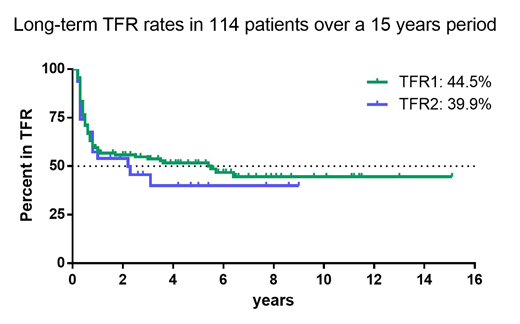Background. The A-STIM (According to Stop IMatinib, NCT1038732) observational study established the loss of major molecular response (loss of MMR, BCR-ABL1 IS >0.1%) as a practical and safe criterion for restarting therapy in patients with CML who had stopped tyrosine kinase inhibitors after a prolonged (≥2 years) and sustained deep molecular response (J Clin Oncol. 2014;32(5):424-30). We focus now on the long-term prospective follow-up of a cohort of 114 patients from a single institution included in the A-STIM observatory in order to describe late events (late molecular relapses after 2 years or more in TFR and second TFR attempts).
Methods: Adult chronic phase CML patients treated with tyrosine kinase inhibitors and in sustained (≥2 years) MR4.5 (BCR-ABL1 IS ≤0.0032%) were eligible. Patients with a previous history of resistance or mutations of the BCR-ABL tyrosine kinase domain were excluded. Molecular relapses were defined by loss of MMR. After TKI discontinuation, BCR-ABL transcripts were monitored monthly during the first 12 months, every 2-3 months during the 2nd year and every 3-6 months thereafter. Median follow-up from diagnosis of CML was 15.9 years.
Results. Over a 15 years period, 114 patients followed at the Centre Hospitalier de Versailles were registered. Median age at diagnosis was 48.2 years, sex ratio was 0.5 and Sokal score distribution was 54%, 26% and 20% for the Low, intermediate and high-risk categories respectively. Median duration of TKIs before the first TFR attempt was 7.4 years. Thirty-six patients (31%) were previously treated with interferon, 62 (54%) received imatinib only and 52 (46%) were on 2G-TKIs at the time of discontinuation (13 as first line therapy and 39 after a switch for sub-optimal response or intolerance). Median follow-up in TFR1 was 5.4 years. TFR1 rates were 57.6% at 1 year, 53.8% at 3 years, 51.6% at 5 years and 44.5% after 7 years. The longest duration of ongoing TFR1 is 14.9 years. The duration of TKIs and the duration of MR4.5 were associated with a higher TFR1 rate; a trend was observed for previous exposure to interferon. Patients on 2G-TKIs (first or second line) had similar TFR1 rates as compared to patients on imatinib. Fifty-seven patients relapsed including 8 patients (14%) experiencing late molecular relapses. Of those, 4 patients relapsed after 5 years. The latest molecular relapse was observed after 6.4 years. In late relapsing patients, MR4.5 was lost after 10 months in median and MR4 after 22 months with a long-lasting period of fluctuations of the BCR-ABL1 ratio in-between MR4 and MR3 (a focus on patients with fluctuations of the BCR-ABL1 ratio will be presented at the congress). Out of the 57 patients who restarted a TKI, 31 patients (54%) experienced a second attempt. Median duration of TKIs between TFR1 and TFR2 was 2.9 years and total exposure to TKIs before TFR2 was 9 years. Fifteen patients (48%) were on imatinib before TFR2 whereas 16 where on 2G-TKI (52%). Median follow-up in TFR2 was 3.4 years. TFR2 rates were 53.9% at 1 year, 45.6% at 3 years and 39.9% after 5 years. The longest TFR2 is 9 years. No factor was associated with TFR2 duration, a switch to 2G-TKIs did not provide any advantage. Seventeen patients relapsed including 3 patient (17%) experiencing late molecular relapses. Anecdotally, 5 patients went to a third TFR attempt and 1 is in TFR3 for 5.2 years.
Conclusion. Based on a 15 years' experience we were able to report on long term follow-up in TFR1 and in TFR2. Among patients experiencing molecular relapses, we observed 14% and 17% late relapses after more than 2 years after TFR1 and TFR2 respectively, suggesting that a long-term molecular follow-up is mandatory for CML patients in TFR.
Rousselot:Incyte: Research Funding; Pfizer: Research Funding. Cayuela:Incyte: Honoraria, Speakers Bureau; Novartis: Consultancy, Honoraria, Speakers Bureau.
Author notes
Asterisk with author names denotes non-ASH members.


